Guest-Writer's Submission
Traditional Puppetry in Taiwan
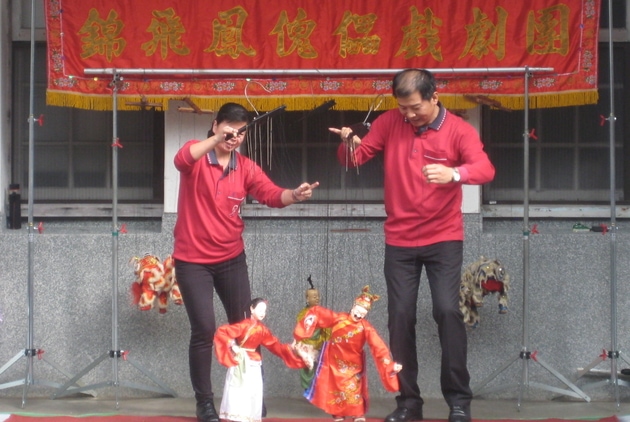
Source:Richard Bradshaw
Chinese settlers originally came from the closest mainland province of Fujian and brought with them the Fujian Hokkien dialect which became the language now called Taiwanese, spoken by about 70%. They also brought their traditional forms of puppetry.
Views
Traditional Puppetry in Taiwan
By Richard Bradshawweb only
Richard Bradshaw has been a full-time puppeteer since 1969. He has performed with his shadow puppets for audiences of children and adults in Europe, North America and Asia, making some 50 overseas tours. The text was written in early 2017 following his time in Taiwan in December 2016 as a guest to the 2016 Asia Pacific Traditional Arts Festival. This article is reproduced with his kind permission.
In December 2016 I had the good fortune to be a guest at the 2016 Asia Pacific Traditional Arts Festival which this time concentrated on puppetry. The event included a tour to meet leaders in the field, a week-end Puppet Carnival and an International Forum, and was organised by The Puppet and Its Double with Artistic Director Cheng, Chia-yin, known to us as Jo Cheng.
It was our fourth time in Taiwan, a country with a dynamic economy and friendly, industrious people. The account of puppetry that follows should be regarded as an outsider’s impression only.
Historical Background
The indigenous people of Taiwan are ethnically similar to Filipinos, but they are greatly outnumbered by Chinese from the mainland. Chinese settlers originally came from the closest mainland province of Fujian and brought with them the Fujian Hokkien dialect which became the language now called Taiwanese, spoken by about 70%. They also brought their traditional forms of puppetry.
From 1895 to 1945 Taiwan was ruled by Japan, but at the end of WW2 it was incorporated into the Republic of China [R.O.C.]. In 1949 the Nationalist leaders and supporters fled to Taiwan which remains as the R.O.C. and Mandarin became the official language of Taiwan although in the south Taiwanese is preferred. A difficulty for foreigners is the use of different systems of romanisation, even though Han Pinyin is now official. In what follows I cannot always be confident of accuracy and sometimes give two different romanised forms of a name.
Marionettes
Taiwan’s only professional marionettes are the traditional string-puppets of the Kaohsiung-based Chin Fei Fang Marionettes of Hsue, Ying-yuan and his wife. The company was started by Mr. Hsue’s grandfather in 1920 and uses the style of marionette found in Quanzhou with the “paddle”-style of control. One figure Mr. Hsue demonstrated was able to lift a trunk with its hands by first closing them to grip the handles.
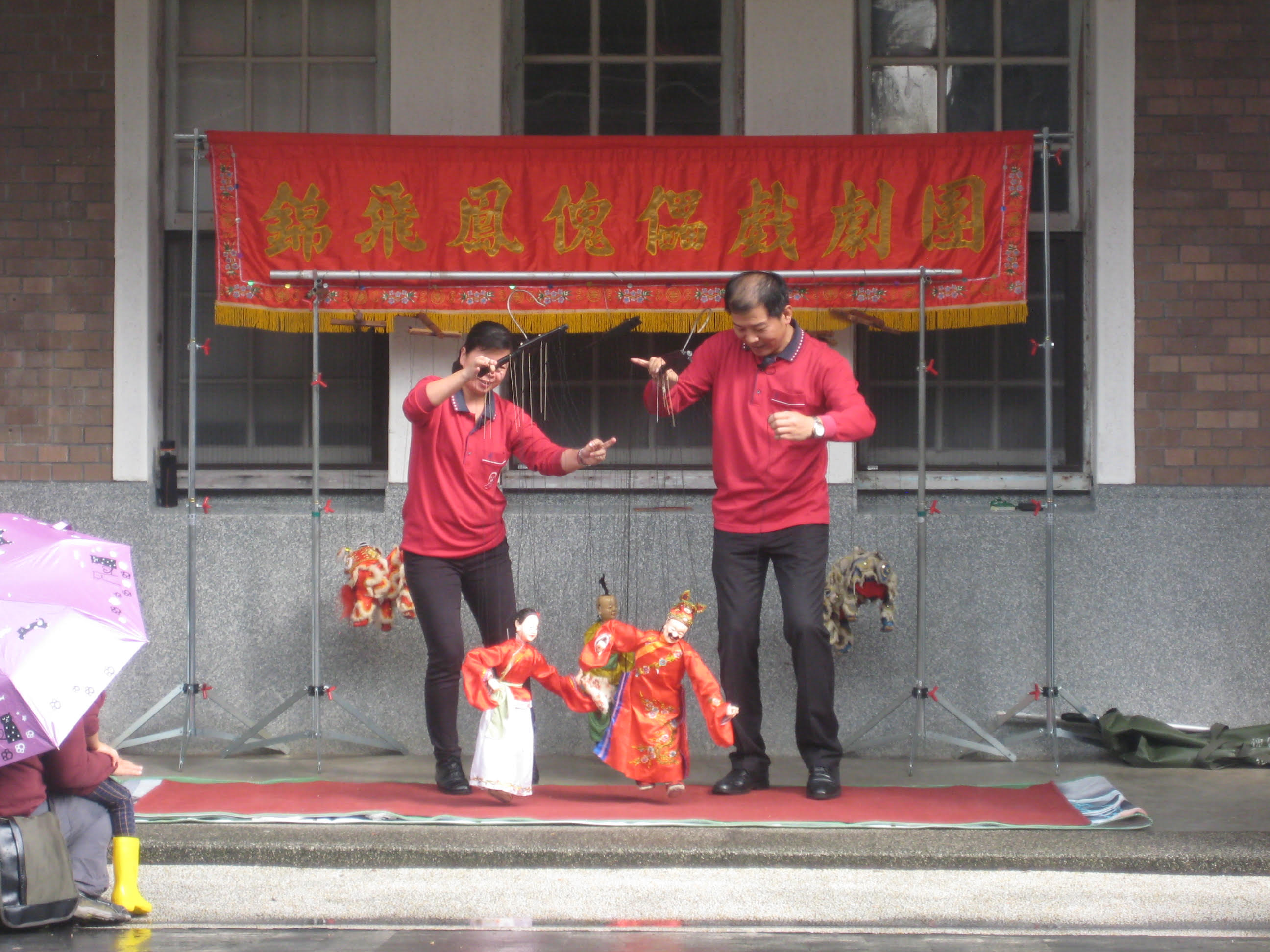 The Chin Fei Fang Marionettes performing at the puppetry carnival in Yilan. (Photo courtesy of Richard Bradshaw)
The Chin Fei Fang Marionettes performing at the puppetry carnival in Yilan. (Photo courtesy of Richard Bradshaw)
Mr. Hsue used to work in a fish-market to supplement his income from performances, mainly given at temples, but now the couple, who have three children, are full-time puppeteers and have travelled overseas. If you Google on the company’s name you can see YouTube videos of the family performing in Vancouver in 2016.
In a tourist park at the former Suantou Sugar Factory in Chiayi we saw a marionette show that senior citizens present at weekends. These marionettes, with western-style horizontal controls, are not traditional and Mr Huang, who is responsible for the show and makes the puppets, got his inspiration from Bil Baird’s marionettes in The Sound of Music.
Shadow Puppets
A small number of professional traditional shadow-puppet groups are found in the southern city of Kaohsiung. The fast train from Taipei in the north to Kaohsiung in the south takes an hour-and-a-half to go the roughly 300 Km [with a few stops en route]. At the Kaohsiung Museum of Shadow Puppetry, in the Gangshan district school-groups can learn to make shadow puppets. The museum now also houses an extensive display of hand-puppets.
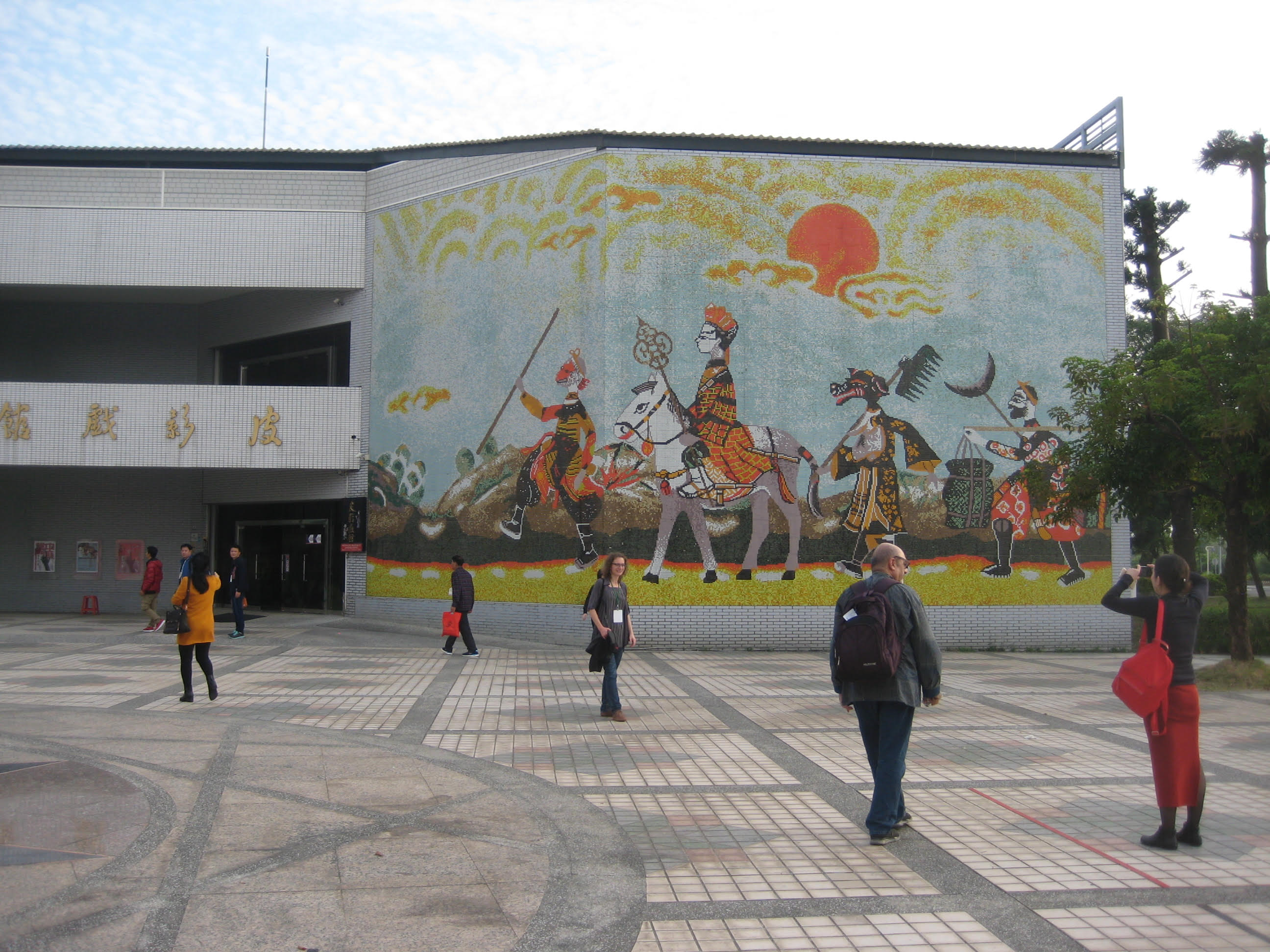 The Kaohsiung Museum of Shadow Puppetry. In the foreground are Zuzana Vojtiskova, editor of a Czech book on the living legacy of puppetry, Dadi Pudumjee, President of UNIMA and Xiaoxin Wang, puppetry scholar at Shanghai Theatre Academy. (Photo courtesy of Richard Bradshaw)
The Kaohsiung Museum of Shadow Puppetry. In the foreground are Zuzana Vojtiskova, editor of a Czech book on the living legacy of puppetry, Dadi Pudumjee, President of UNIMA and Xiaoxin Wang, puppetry scholar at Shanghai Theatre Academy. (Photo courtesy of Richard Bradshaw)
Companies which continue to present traditional shadow-play are the Fu Hsing Ko [Fuxingge] Shadow Puppet Troupe, the Yung Shing Le [Yongxingle] Shadow Play, and the Tung Hua Skin Shadow Puppet Theater. These companies have been led by successive generations of families and the last-mentioned claims to be the oldest puppet company in Taiwan. By Googling on their names you can see YouTube videos of the work of all three, some with English subtitles.
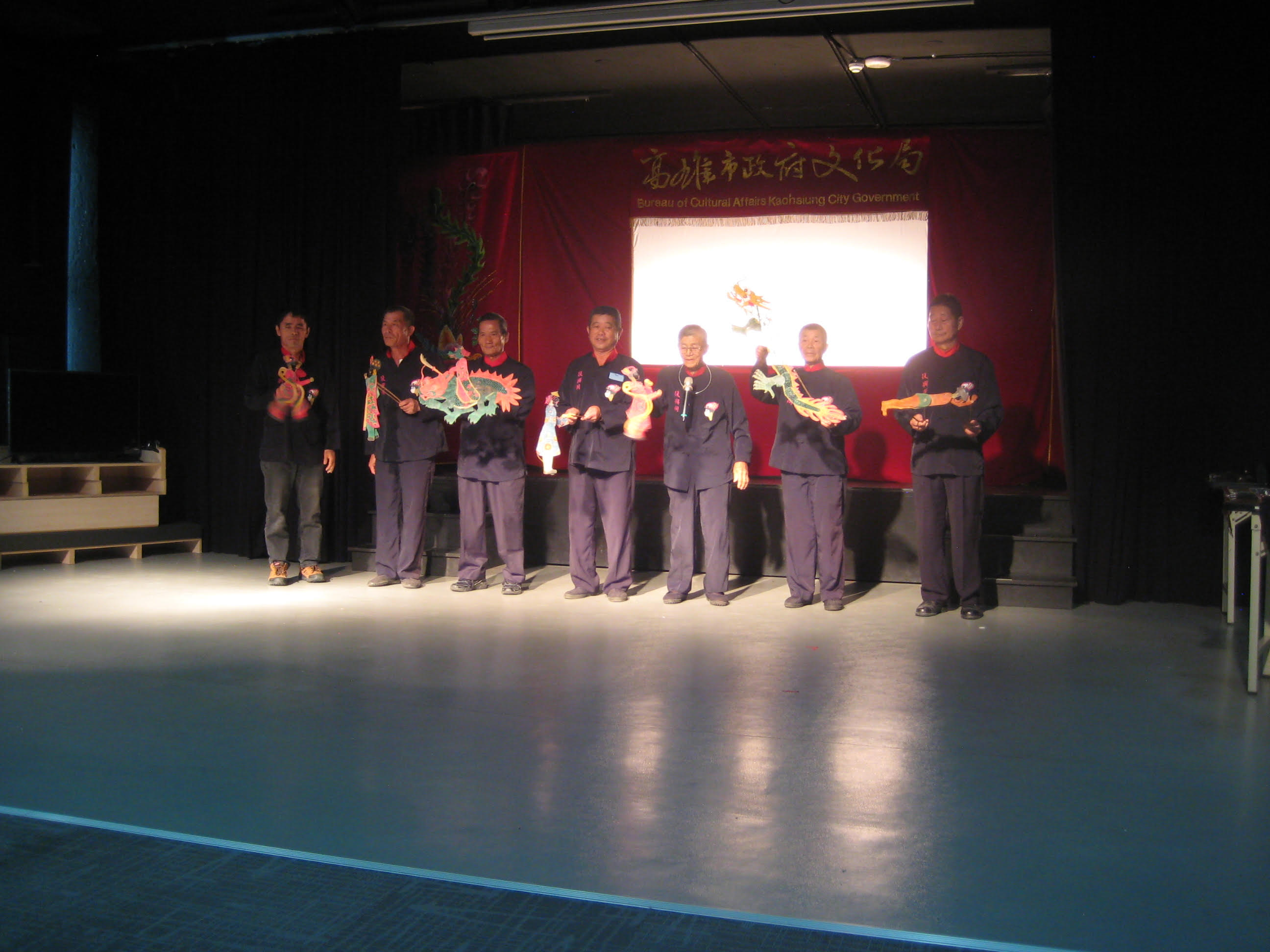 Puppeteers of the Fu Hsing Ko [Fuxingge] Shadow Puppet Troupe. (Photo courtesy of Richard Bradshaw)
Puppeteers of the Fu Hsing Ko [Fuxingge] Shadow Puppet Troupe. (Photo courtesy of Richard Bradshaw)
The traditional shadow-figures differ from those we know from China in the way they are worked. The coloured leather figures are operated with rods fixed at right-angles to the figure, not unlike the rods of Turkish/Greek figures, except they are not detachable. Although this technique does not seem to have survived on mainland China it is sometimes called the Chaozhou Shadow Tradition after a town in northern Guangdong close to the border of Fujian, from where the tradition probably came.[1] It is a technique that is not widely known outside Taiwan.
A standard figure is worked by two round wooden rods. The rod to the body is loosely held to it by a hole in a strip of leather at the shoulders, so that the body can swing freely. This rod passes through holes in the shoulders of both arms. The fit is tight for the first, unjointed arm and when the rod turns this arm turns with it. The fit is loose for the second arm so it hangs loosely on the rod.
A rod to work the second arm is firmly attached to the hand. This arm has a knotted-string elbow-joint and a hole at the wrist through which the rod passes. A groove around the rod stops it from sliding through the hole, but still allows the rod to turn freely in the hole. [There are similar grooves on the body-rod for the body and the shoulder of the second arm.]
The freely-hanging legs are joined by a knotted string to the body at the hips, and only one leg has a knee joint. The neck fits into a flat collar which allows it to be removed when stored, I believe for animistic reasons.
So while both arms are firmly controlled by the rods, the body, with the legs, swings freely from the body-rod. A skilled puppeteer is nevertheless able to make the figure walk, sit on a chair etc.
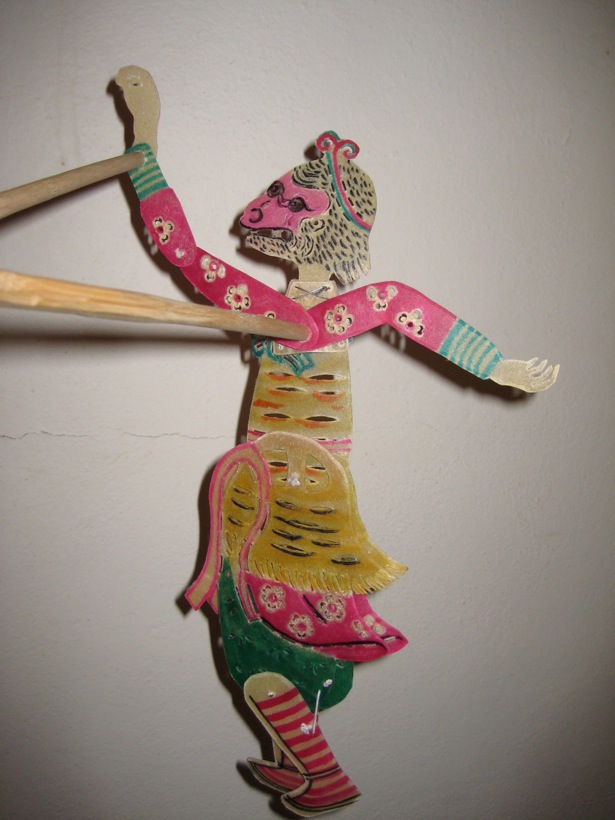
A shadow figure made in the traditional way by Wang, Chung-Cheng
(Photo courtesy of Richard Bradshaw)
There are other shadow groups in Taiwan, including some which have moved away from traditional forms and stories. A Paper Shadow troupe we saw in Kaohsiung used brightly coloured plastic figures with scenes constructed on clear plastic on removable frames. Even the translucent screen itself could be removed so that the audience could finally see clearly through to the operators.
Glove Puppets
By far the strongest tradition of puppetry in Taiwan is that of the glove puppet which has evolved into the hugely successful modern Pili Puppets on TV.
The Taiwanese/Fujian word potehi means “cloth bag theatre” and the Mandarin equivalent is budaixi . Another term translates as “palm of the hand theatre.” The potehi often accompanied people from Fujian when they moved to other parts of the world.
There is a description of a show in 1857 in the Australian goldfields town of Bendigo and a wayang potehi tradition exists in Indonesia. Roberta Stalberg’s book China’s Puppets is very informative on the continuing tradition in Fujian and an excellent account by Robin Ruizendaal of the Taiwanese tradition is found in a recent book, Potehi, published by the Taiyuan Asian Puppet Theatre Museum in Taipei, of which he is director.[2] He reveals that in a 2006 a government sponsored national opinion poll the glove puppet theatre was chosen as the most representative symbol of Taiwan, way ahead of the highest mountain and the tallest building [once the tallest in the world].
The puppets have a “cloth bag” as an undergarment. The thumb goes to one hand, the forefinger is inside the neck and the other three fingers are held flat on the side of the other hand. Hands for figures that don’t need to hold things such as weapons are usually jointed.
Traditionally the heads were much smaller than those found on European glove-puppets and this means that the proportions of the puppet are closer to those of humans, albeit rather stout humans. The legs can move in response to the body, or may be operated by the other hand. Viewed close-up a well manipulated puppet can be surprisingly realistic.
Pili Puppets (Photo by Chien-Tong Wang/CW)
While there were also once travelling solo players with simple folding stages, the old companies usually had two performers, a master and an apprentice and a small orchestra which was not always permanently linked. (The status of musicians was much higher than that of puppeteers.)
Shows were usually given at temples, especially to venerate one or both of two patron deities, and the stages were elaborately carved wooden structures.
Stories with fight sequences are particularly popular and a puppeteer will conduct a vigorous battle between two puppets using different weapons. One puppeteer told us that it could take a full day to make one of the elaborate weapons, the same time that he would spend making three heads.
The puppets are also able to do such tricks as balancing spinning plates, juggling a rod, using a fan and shooting arrows, but the most surprising trick for the outsider is when the puppeteer tosses the puppet up into the air it falls back on to his hand, or even that of another puppeteer. This means a puppet can do an aerial somersault or even jump to the top of a building.
The language in the puppet shows is almost always Taiwanese, even for Taipei, and today the Chinese text may be projected at the sides of the stages.
Until war with China began in 1937 the Japanese occupation of Taiwan since 1895 did not seriously affect the puppet theatres and today’s leading companies date back to that period.
But when war began it was accompanied by “Japanification.” Outdoor temple performances were curtailed but indoor performances in theatres were allowed, with a mix of Japanese and Taiwanese language and recorded music. The old carved stages were replaced by large coloured cloth-covered structures which have now become the norm.
We visited the Yo-Ming Stage Set Company which paints most of today’s puppet cloths in gaudy, fluorescent colours. Instead of shows being paid for by temples, people had to buy tickets and one positive result was a spurt of creativity to attract audiences.
“The Puppetmaster” [1993], a film directed by Hou, Hsiao-hsien and considered a masterpiece, is based on the life of the celebrated puppeteer Li, Tian-lu (1910-98) who appears as himself. It deals with his life under Japanese occupation until 1945. Li, Tian-lu was a guest at the 1988 Charleville (France) festival, and Le Petit Miroir is a French puppet company founded in 1978 by Jean-Luc Penso who trained with him.
While Taiwanese companies weren’t brought together to form large state companies, as on the mainland after 1949, it became necessary to play to larger audiences, and the small heads of the old puppets were a disadvantage.
It is not absolutely certain when, but puppeteers started to make figures with larger heads and this led to what are now called Golden Ray or Golden Light Puppets, the version most often seen today. The modern shows can be very elaborate affairs, with especial lighting effects, scenery on vertical rollers, rain using real water, modern bands etc. We saw one villainous puppet whose head could extend upwards and shoot out fire using gas.
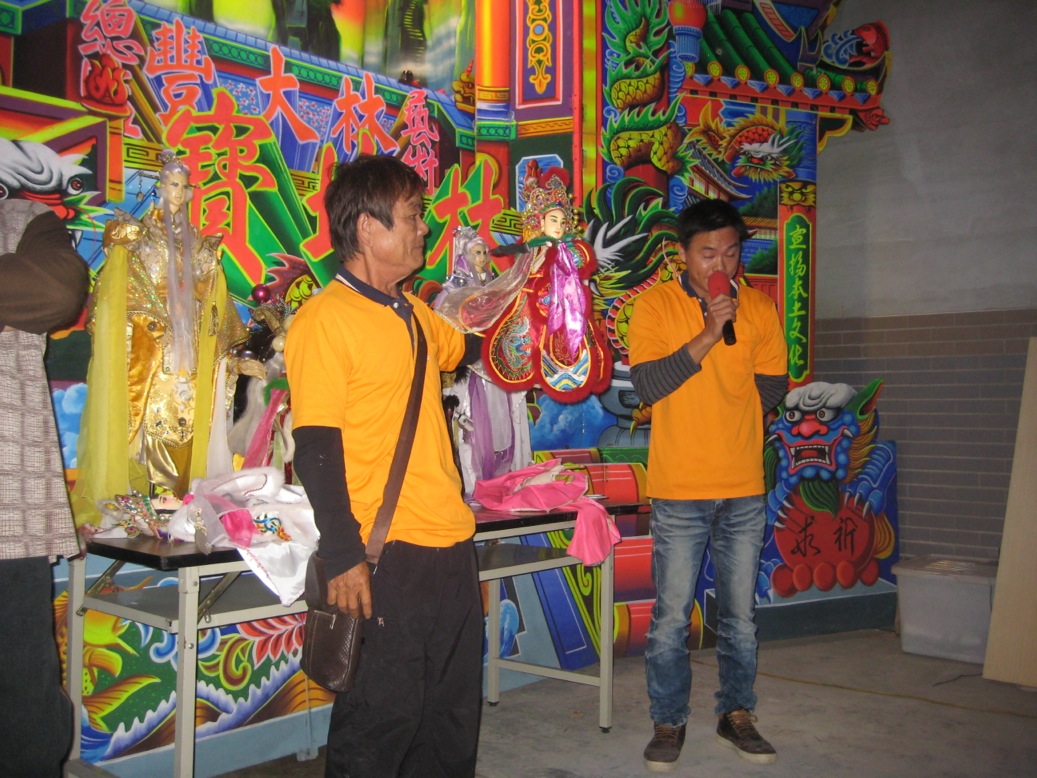 Puppeteers show us a Golden Ray figure in front of their stage. There are Pili-style figures in view. (Photo courtesy of Richard Bradshaw)
Puppeteers show us a Golden Ray figure in front of their stage. There are Pili-style figures in view. (Photo courtesy of Richard Bradshaw)
A very important family of puppeteers is the Huang family, now associated with the Pili puppets. Huang, Ma was an illiterate “cookie-vendor” who started to use a couple of puppets to attract customers. The crowds grew so he set up a stage on a cow-drawn cart and his son started working with him.
The son, Huang, Hai-dai, became one of Taiwan’s treasured puppeteers and during WW2 his company was one of only 10 theatre groups the Japanese chose to promote their cause around Taiwan. He was 106 when he died in 2007 and an iron silhouette of him stands outside the puppet museum in Yulin which has an impressive display from traditional potehi to modern Pili.
This story was told to us by his son, Huang, Jun-xiung. He attended a Japanese school during WW2 and began his work with the puppets as a musician. He can play instruments, do voices, and work the puppets and is often credited with the creation of the Golden Ray style.
From 1970 he had great success with TV puppetry, when shows were broadcast live. These shows were so popular that the Nationalist government stopped them in 1976 on the grounds that they were distracting people from their work, but the government may also have been unhappy that the language was Taiwanese, and not the Mandarin they promoted. Huang, Jun-xiung now has a studio recording shows not unlike those of his sons at Pili.
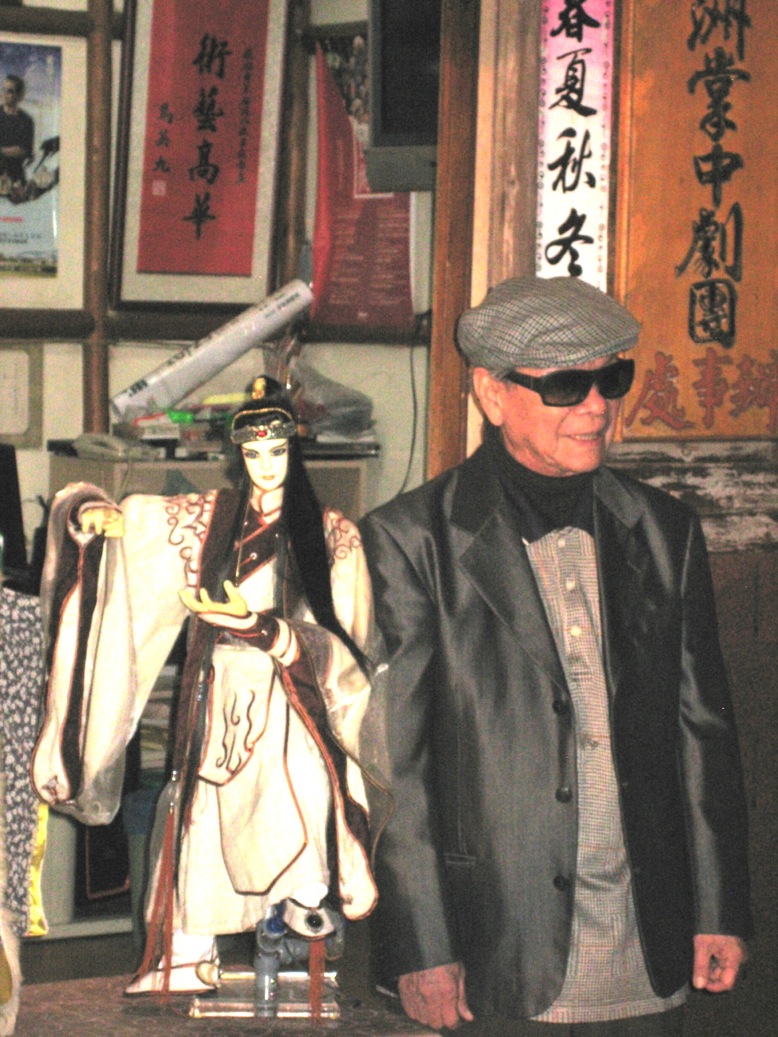
Huang, Jun-xiung at his film studio alongside one of the figures.
(Photo courtesy of Richard Bradshaw)
The Pili puppet have been phenomenally successful, appealing to a young audience that is less in tune with traditional potehi or budaixi. They use a larger form of puppet created especially for TV. From a diagram at the Kaohsiung museum it seems that a basic figure still has the puppeteer’s forefinger in the neck, but three fingers operate a wire armature which gives movement to one extended arm, and a rod hidden by the elaborate flowing robes controls the other at the elbow.
Then there are complicated mechanisms, moving features, smoke, digital effects and so on. The figures have long faces, with long noses and pointed chins which we were told are favoured by the fans. By Googling on Pili you can get an idea of the puppets and the vigorous martial encounters. The leading character, Su Huan Jen, is quite complex and not always the one favoured by fans. In a departure lounge at Taipei’s Taoyuan Airport one large space is occupied by a display of Pili puppetry.
Pili International Multimedia Co., Ltd. Is in the top hundred listed companies in Taiwan, but is still managed by the Huang family. Our group was made very welcome at its huge studio building in Huwei, Yunlin County. Chris Huang, the Chairman, is also the script editor, basing stories on Chinese history and legend, and his brother, Vincent, the Vice-Chairman, continues to provide the great range of voices.
Chris Huang commented that we all know that the puppets are without life, and should be grateful to the puppeteers for giving their life to the puppets. The company has been working on Thunderbolt Fantasy for Japan and has also made a 3-D film with Warner Bros. Pili has created something hugely successful, very modern and uniquely Taiwanese.
Maintaining The Tradition
Yulin hosts an annual puppet festival in October. Famous puppet groups are invited and compete for a Golden Palm Award. In 2007 eight troupes from Yulin competed, but in 2008 the award was extended to all Taiwan, and is now for professionals only. (There are about 1,000 potehi companies in Taiwan of which about 300 are professional.)
Creativity and innovation is encouraged and there is now also a budget for training, mainly in elementary and junior schools. Since 2011 there has been a Little Golden Palm Award for students. Even then, there is still the problem that fewer and fewer people want to learn the skills.
Puppetry was originally a man’s profession, but more women are becoming involved. The first prominent female player was Jiang, Si-mei. Her father was a musician for puppet shows but she decided she wanted to be a performer and established the Happy Puppet Company in 1967.
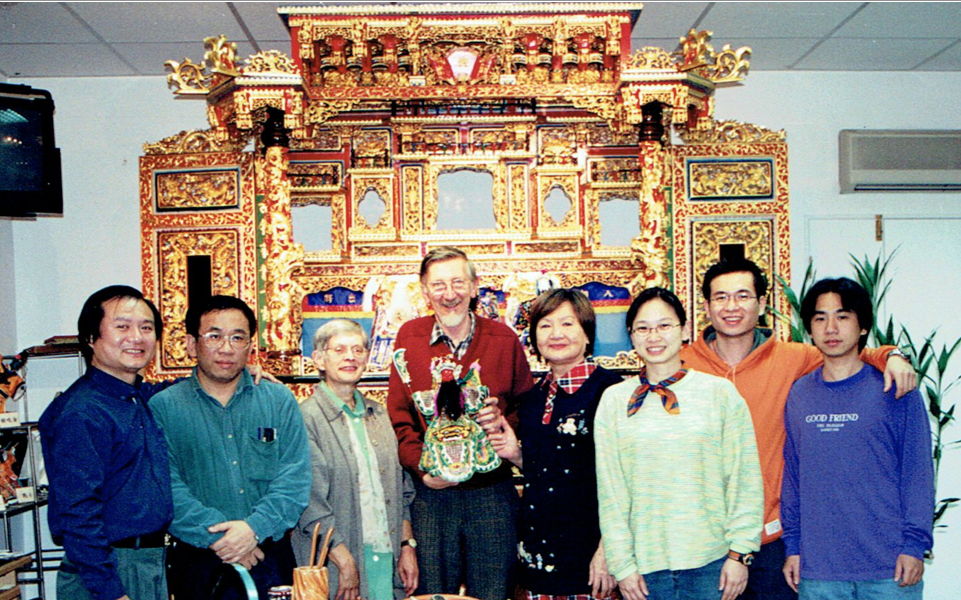 At home with the Happy Puppet Theatre, Taipei in 2001. Note the carved theatre in the background. I was given the puppet I am holding. To the right of me is Jiang, Si-mei, then Cheng, Chia-yin and Ko, Shih-hung, all mentioned in the text. (Photo courtesy of The Puppet and its Double.)
At home with the Happy Puppet Theatre, Taipei in 2001. Note the carved theatre in the background. I was given the puppet I am holding. To the right of me is Jiang, Si-mei, then Cheng, Chia-yin and Ko, Shih-hung, all mentioned in the text. (Photo courtesy of The Puppet and its Double.)
Now 83, she was performing in Vancouver earlier in 2016 with her son and two grandsons. The Puppet and Its Double[3], based in Yilan, is an excellent contemporary company with a strong European flavour and in 2005 the company celebrated the life of Jiang, Si-mei in a play, The Puppeteer Granny which starred her grandson Ko, Shih-hung.
There is impressive support for puppetry in Taiwan and academics are doing their best to nurture the tradition. The Taipei Council wants all Year 2 Elementary schoolchildren to visit one of Taipei’s three puppet museums and these receive a voucher worth about U.S.$10 per student for this.
The great irony is that a country with so much puppetry, traditional and modern, cannot have a national centre of UNIMA (the international association of puppeteers) because its status continues to be in dispute.
About the Author
Richard Bradshaw has been a full-time puppeteer since 1969. He has performed with his shadow puppets for audiences of children and adults in Europe, North America and Asia, making some 50 overseas tours.
Richard’s puppets were featured in the first series of The Muppet Show and were the basis of a one-hour documentary made by Jim Henson with the ABC in Sydney in 1984. He has contributed chapters on shadow puppets to books published in Germany and Spain, and Richard Bradshaw’s Guide to Shadow Puppets was published by Charlemagne Press [Canada] in 2015. He has also written on the history of puppetry in Australia.
From 1976-83 Richard was Artistic Director of the Marionette Theatre of Australia based in Sydney.
In 1986 Richard received the Medal of the Order of Australia (OAM) “for services to the arts as a puppeteer” and in 2016 he was made a Member of Honour of UNIMA.
[1] Fan Pen Li Chen, Chinese Shadow Theatre, (Montreal & Kingston: McGill Queen’s University Press, 2007)
[2] Kaori Fushiki & Robin Ruizendaal [editors], Potehi: Glove Puppet Theatre in Southeast Asia and Taiwan (Taipei: Taiyuan Publishing, 2016)
[3] The Puppet and Its Double was founded in 1999 by Jo Cheng who studied Puppetry at the University of Connecticut under Bart Roccoberton who was with us in Taiwan. Two of Jiang, Si-mei’s grandsons also studied there.











